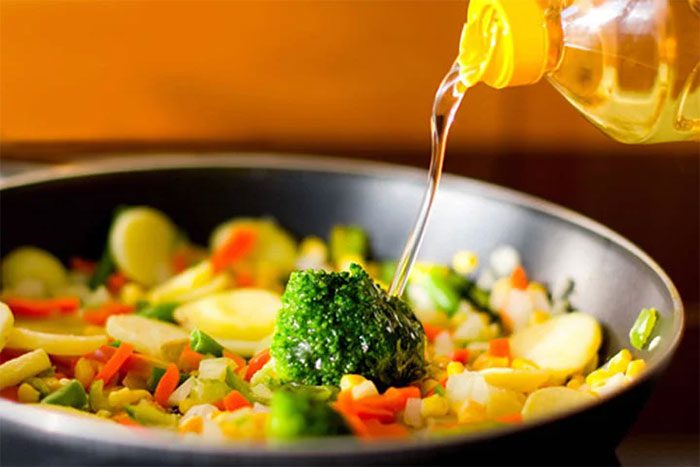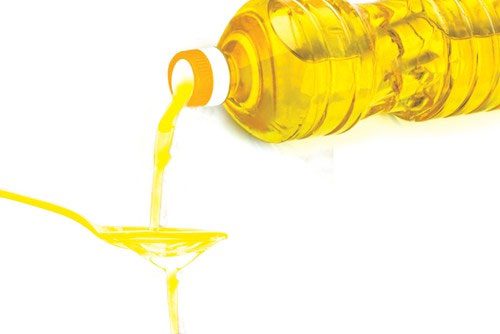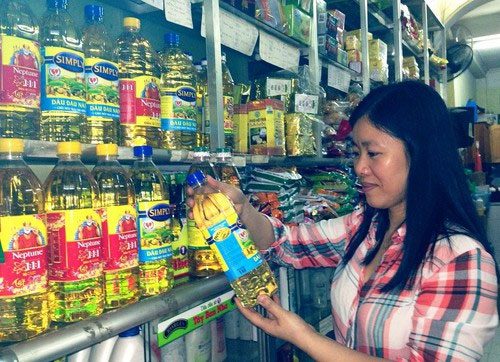According to the National Institute of Nutrition, every household should have two types of cooking oil for different food preparations.
>>> 6 Tips for Healthy Cooking Oil Usage
Two Types of Cooking Oil Recommended in the Kitchen
At a recent seminar titled “Guidelines for Safe and Healthy Cooking Oil Use” organized by the Vietnam Women’s Union in collaboration with the Food Safety Department (Ministry of Health), nutrition experts stated that every household should have two types of cooking oil available.
One type is for stir-frying, salad dressing, soups, and marinating meat and fish; the other type is for frying.
Cooking oils such as sunflower oil, soybean oil, canola oil, and olive oil should be used for stir-frying, raw consumption, and marinating foods. This helps users effectively absorb vitamins A, D, E, and K present in foods, supplement essential fatty acids, and enhance the flavor of dishes. Cooking oil blends are suitable for frying due to their ability to withstand high temperatures during cooking.

Every household should have two types of cooking oil at home.
Used oil and fat from frying should be discarded and not reused multiple times (maximum use is 2 times) because high temperatures can generate trans fats and other harmful components that are detrimental to health. Opened oil should be consumed within about one month.
Avoid Using Oil at High Temperatures
High temperatures not only destroy the nutritional components of food but also produce peroxides and harmful substances. When the temperature exceeds the “smoke point” of the oil, it burns, smokes, and emits a burnt smell.
Cooking at higher temperatures (such as allowing oil to smoke in the pan) increases the number of times the oil is reused, which leads to more toxic substances being generated.
Some of these toxins evaporate into the air, causing air pollution, which can be harmful when inhaled; while others settle into the oil, contaminating food and posing serious health risks.
Symptoms of consuming these harmful substances can include dizziness, nausea or vomiting, abdominal pain, difficulty breathing, a slow heart rate, high blood pressure, fatigue, and prolonged consumption may increase the risk of cancer.
Additionally, cooking oil that is repeatedly heated at high temperatures can destroy fat-soluble vitamins such as A and E, reducing the nutritional value of the oil.
Therefore, it is best to cook at moderate temperatures, especially when frying, to ensure food is cooked deeply without burning the oil. If you have a habit of stir-frying food when the oil is smoking, it’s advisable to change this practice by heating the pan first, then adding the oil, and immediately adding the food to be cooked.
Do Not Reuse Cooking Oil Multiple Times
Used cooking oil should ideally be discarded and not reused, as repeated heating destroys vitamins and other nutrients in the oil, leading to the formation of harmful substances and food residues that are not visible to the naked eye. Regular consumption increases the risk of cancer. Furthermore, reused cooking oil is more prone to oxidation, resulting in undesirable changes in the taste and color of the dish. Foods fried in fresh oil will have a vibrant color and delicious taste, whereas those fried in reused oil will appear dark yellow, unappetizing, and unsafe for health.

Frozen Cooking Oil is Not Harmful to Health
Cooking oil that solidifies at low temperatures is a normal physical phenomenon, similar to water freezing into ice. There is no chemical change affecting the quality of the oil, so it does not pose a health risk. Therefore, the degree of solidification of cooking oil cannot be used to assess product quality. To prevent oil from solidifying, it should be stored at a temperature of 25°C. When oil solidifies, simply immerse the bottle in warm water, and the oil will return to a liquid state for normal use.
As we age, the need for fats, especially animal fats, decreases because cholesterol and fatty acids found in animal fats can increase blood cholesterol levels, leading to a higher risk of cardiovascular and metabolic diseases. At this stage, it is necessary to reduce the proportion of animal fats in the diet and focus on using vegetable oils like soybean oil and olive oil to protect health. These oils contain high levels of omega 3, 6, and 9, which have high biological activity and help metabolize bad cholesterol in the blood, thereby preventing cardiovascular diseases and hypertension.

Interchanging Cooking Oils for Children
Younger children have a higher fat requirement, which can reach up to 40% of total energy intake to meet their rapid growth and development needs in the early years. During this period, it is essential to provide a full and diverse supply of fats from both animal and plant sources, especially DHA and omega 3, which are abundant in salmon oil and certain vegetable oils. Therefore, it is advisable to alternate different cooking oils to provide a variety of nutrients for children. Another effective and convenient option is to use specially formulated cooking oil for children that includes salmon oil and various vegetable oils such as rice oil, sesame oil, and canola oil.
Proper Storage of Cooking Oil
Users should store cooking oil in a cool, dry place away from heat sources and sunlight. Additionally, oil can be stored in clay jars or clean, dry glass bottles with tight lids. If water enters the container or bacteria and air infiltrate, the oil will spoil quickly. It is not advisable to store cooking oil in metal containers, as they often can lead to oil spoilage.
How to Cook with Oil for Better Flavor?
According to the National Institute of Nutrition, when stir-frying food, to ensure it is both delicious and retains the quality of the fat, it is recommended to sauté a little onion or garlic with the fat before adding the food, seasoning it adequately, cooking through, and then adding 1-2 tablespoons of cooking oil and mixing well before removing it from the heat.



















































